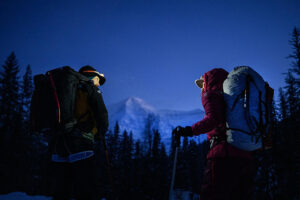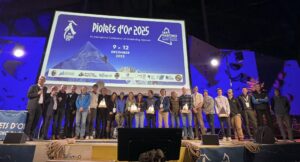There is a good reason why Paul Ramsden and Tim Miller called their new route on Jugal Spire The Ghost Line, and a good reason why no one had climbed it before them. The peak — surprisingly close to Kathmandu — features, according to Ramsden, “one of the biggest, steepest rock walls in Nepal”.
“It’s an unlikely line,” Ramsden told ExplorersWeb in an interview shortly after the climb. “It shouldn’t really be there on that granite face.”
Moreover, there was no way to spot it from Base Camp. The climbers had to find their way up as they ascended a deepening, narrow gully.
On the other hand, that was exactly the right challenge for Ramsden, a remarkable representative of exploratory alpinism. “I wouldn’t think of climbing any other way,” he said.

Their route up Jugal Spire. Photo: Ramsden/Miller
COVID silver lining
Everything started, as with many projects in the last few years, during the COVID lockdown. As Ramsden first reported for the UK’s Alpine Club:
To be honest, I had never considered climbing in the Jugal Himal until the Covid lockdown in the UK left me with far too much spare time on my hands. For me, spare time usually means time spent online researching possible climbing objectives. While cruising around on various forms of satellite imagery, I spotted a very steep face in the Jugal that I had never noticed before. Zooming out on the satellite image, I realized the face was to be found on an outlier of Dorje Lhakpa and represented a very significant peak itself. The Peak was marked 6,563m on the map and bizarrely was quite possibly the nearest 6,000m peak to Kathmandu. Research seemed to indicate that not only was the peak unclimbed, but it also seemed to be unattempted. Before I knew it, my mind was made up and I was heading for the Jugal with only a vague satellite image to go by and the promise of lots of adventure.
This time, Ramdsen’s partner was not Mick Fowler (with whom he’s won three Piolets d’Or), but a rookie half his age — part of a mentoring program. Tim Miller of Scotland was young and enthusiastic, and they got on well from the start.
After a bus trip and some days trekking, the team set up base camp at the junction of the streams below the Lingshing Glacier.
“From base camp, we could see the south side of Peak 6,563m but we couldn’t see the north face of the mountain, where we hoped to find something steep and icy,” Ramsden recalled.
The pair first did an acclimatization round on the west ridge of nearby Dorje Lhakpa Peak. At the same time, they tried to get a better glimpse of their targeted face.
“When the weather allowed us to see the north face of 6,563m for the first time, it would be an understatement to say that we were impressed,” said Ramsden.

The imposing wall from the distance. Photo: Ramsden/Miller
Is there a route at all?
They were looking for an ice line on a huge granite face, and they found it, sort of.
“A steep ice line did exist, crossing the face from the lower right corner to the snow fields just below the summit, [looking] steep, very steep, and enough sections [seemingly] devoid of ice to make us doubt whether it was possible.”
It took several days of bad weather and two days to approach the base of the face in difficult snow conditions. Finally, the climbers were poised to go. The wall looked intimidating.
“The steepness of the face meant that after the first few pitches, we couldn’t see any ice at all on the face, just a steep wall of granite rising up into the clouds,” Ramsden said.

Tim Miller. Photo: Paul Ramsden
The first day started on not-so-steep terrain up some snowfields to the base of the face. Once there, the climbers had to progress up steep icy runnels.
“In places, the ice thinned to nothing and forced us to make delicate mixed climbing moves on granite slabs, sometimes devoid of protection,” Ramsden recalls. Eventually, they carved a snow ledge for their first bivouac.

Bivy on Jugal Spire. Photo: Tim Miller
Up the chimneys
The second day, they faced the main rock wall and the uncertainty of not knowing whether there would be an ice route up. But above their bivy spot was a series of chimneys that had been invisible from below. Some passages were so narrow that they had to climb without backpacks and haul them up later.
“Over three pitches, we squeezed, thrust, and generally groveled out way up,” Ramsden said. “Eventually, we topped out of the chimney, exhausted but confident that we had overcome the most uncertain stretch of the route…Though never count your chickens till they’re hatched.”

That night, falling spindrift forced the pair to abandon their bivy hammock and endure the night in the open. Fortunately, conditions and weather improved the following day, when they climbed thick ice in granite grooves. By the end of the day, they had reached the summit snow fields. They pitched their hammock, and luckily endured no spindrift.
“The tent was no longer usable as a tent, so we just wrapped the fabric around ourselves and settled in for the night,” Ramsden said.
Almost there

Hard, thin ice on granite. Photo: Ramsden
The summit snowfields were bullet-proof hard ice. This slowed them down so much that discouragingly, they couldn’t reach the summit that day. But they found a snow cave some 50m below the top and sheltered inside from the elements.

Climbing on hard ice fields toward the summit. Photo: Ramsden/Miller
They continued on to the summit the following morning. The way down was easier than they expected.
“Fortunately, a comparatively easy snow slope and gully led first south then west to the Lingshing Glacier, where we spent the night before carrying on down to base camp the following day,” Ramsden explained.
“We named our route (ED, 1,200m) the Phantom Line because of the ephemeral nature of the ice and the ability of the line to appear and disappear under different light conditions when viewed from a distance,” Ramsden said.
They provisionally called the peak Jugal Spire, since they thought it was unnamed. Later, they discovered that locals referred to it as Dorche Lhakpa II.
Here’s a video of the ascent:






